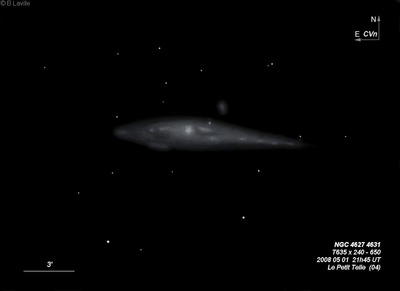Whale Galaxy
Whale Galaxy

William Herschel discovered NGC 4631 = H V-42 = h1397 on 20 Mar 1787 (sweep 722) and recorded "vB, mE from sp to nf, but near the parallel. About 16' long and mbM. A little below the center of it is a small star, but probably unconnected." John Herschel made two observations and called it (sweep 74) "vmE; a long ray which crosses the whole field, rather curved upwards (to south). Has a vF nucleus and a B * nearly in the parallel." His sketch of the pair is on plate XV, figure 76 of the Slough Observations.
Three observations were made at Birr Castle. On 26 Mar 1848, William Rambaut (Lord Rosse's assistant), wrote, "A most extraordinary object with a B * near the centre, and at the right [north] masses of light appear through it in knots." George Johnstone Stoney made a detailed sketch on 19 Apr 1849 (published in the 1850 PT paper). William Lassell sketched the galaxy on 27 May 1862 from Malta (plate V, figure 24) and included a knot on the west side, the bright region east of center, and a third knot towards the east end. To determine a position, Kobold measured two of the knots/star clouds - one on the west side (#63/64) and the bright region east of the geometric center (#33-36).
300/350mm - 13.1" (5/26/84): stunning galaxy, very bright, unusually large and interesting edge-on E-W, 15'x1.5'. A bright knot is east of the core and a faint knot is west of core. Appears very mottled along the major axis. A mag 13 star is just north of the core. NGC 4627, a companion galaxy, lies 2.6' NW of the center.
400/500mm - 17.5" (6/5/99): at 280x (14' field) this remarkable galaxy runs edge to edge across the field! The surface brightness is unusually irregular with bright and dark mottling across the surface. There is no well-defined core but a prominent knot is close following (east) the geometric center along the north side and a second weaker knot is along the west side. The north edge has an unusually "scalloped" appearance particularly along the west side due to dust and brighter splotches. The galaxy gradually bulges towards the center and tapers at the tips, particularly along the west end. A mag 13 star is situated just north of the edge at the geometric center and NGC 4627 appears to hover over this "starship" a couple of arc miinutes northwest of center.
900/1200mm - 48" (4/16/15): Although I've viewed NGC 4631 a few times previously in the 48-inch, it was difficult to take notes as the amount of structure was overwhelming. At 375x (13mm Ethos, 16' field), the galaxy stretched across nearly the entire field and consisted of numerous bright luminous patches and irregular dark patches. The overall shape is asymmetric; gradually tapering down to nearly a point on the west end, bulging in the center and broader along the eastern side, only narrowing significantly near the very tip.
A mag 13.5-14 star is just north of the western tip. A relatively bright knot (NGC 4631:[HK83]#91-94, from Hodge and Kennicutt's 1983 "An Atlas of H II regions in 125 galaxies") lies 0.6' SE of this star and 5.8' W of center. Several obvious bright knots and splotchy regions line the western side of galaxy: #83 is 4.6' W of center, #79 is 3.9' W of center, #72/74 (a fainter spot) is 3.2' W of center, #63/64 (a prominent region) is 2.2' W of center.
A mag 12.5 star is at the north edge near the geometric center. There is no obvious core to the galaxy, though several bright patches are near the center. #47 is a luminous patch 1' S of the mag 12.5 star and #39/41 is a very bright patch 1.5' ESE of the star. Additional HII patches are lined up on the east side, mostly along the northern edge of the galaxy. #33-36 is a large, very bright patch (star cloud?) 2.4' ENE of center and #19/20 is a smaller knot 3.2' E of center. The galaxy bulges out (star association or arm?) on the south side near the eastern end (3.3' from center) and contains #17/18/21/22. The dusty eastern tip of the galaxy has a very faint HII knot (#5-7).
Notes by Steve Gottlieb